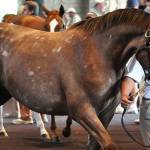Diagnosis and Treatment of Subchondral Cystic Lesions in Horses

Subchondral cystic lesions, also called bone cysts, are abnormalities of bones and joints that may or may not cause lameness. They can occur in multiple sites in horses. These lesions can be caused by injuries, defects in the process by which cartilage turns to bone, or a combination of both factors.
Because the lesions often occur in young growing animals, they are considered to be a form of developmental orthopedic disease. Especially when the lesions occur bilaterally in yearlings (commonly in Quarter Horses and Arabians and some Thoroughbreds), it is felt that cartilage gets retained deeply, undergoes necrosis, and leads to the problem. In older horses, it is felt that the cysts probably result from a defect.
The most common location of subchondral cystic lesions in horses is the medial femoral condyle within the stifle. Less common sites include the proximal tibia, distal aspect of the metacarpus and metatarsus (cannon bones), distal aspects of the radius and in the carpal bones, the proximal radius within the elbow, in the phalangeal bones associated with the pastern and coffin joints, in the shoulder, and in the acetabulum of the hip.
With bone cysts in the stifle, most horses present with a clinical problem between one and three years of age, usually because of a unilateral lameness. A small percentage may be lame in both hind limbs. The severity of the lameness is variable, worsening with work and improving with rest. The diagnosis is confirmed with x-rays. The recommended treatment is arthroscopic surgery to remove the lesion. Conservative management is effective in only about 20% of cases, whereas success with surgery is approximately 70%.
When horses develop bone cysts in the fetlock, they have obvious lameness and filling in the fetlock joint. The lameness can be made worse by flexing the fetlock. These horses will respond to intra-articular blocks of the fetlock, with radiographs confirming the diagnosis. The cystic lesion occurs in the bone under the articular surface of the condyle or the central sagittal ridge of the distal metacarpus or metatarsus (cannon bone). Conservative management usually is unsuccessful, and arthroscopic surgery is recommended.
Subchondral cystic lesions occur within the carpus (knee) but may not cause problems. If they persist and cause clinical signs, surgery is recommended.
Lesions in the pastern joint may occur singly, where they often cause only temporary lameness. More commonly they are multiple, involving the distal surface of the first phalanx. When they are multiple, they generally include severe secondary osteoarthritis (the only subchondral entity that shows this) and the only treatment available is fusion of the pastern.
Subchondral cystic lesions of the elbow are relatively uncommon but may cause significant lameness. The diagnosis is based on upper limb lameness (usually after eliminating lower limb lameness), intra-articular anesthesia to prove the condition is the problem, and radiographic confirmation. Conservative management should be tried initially, as it is equally successful versus surgical treatment.








